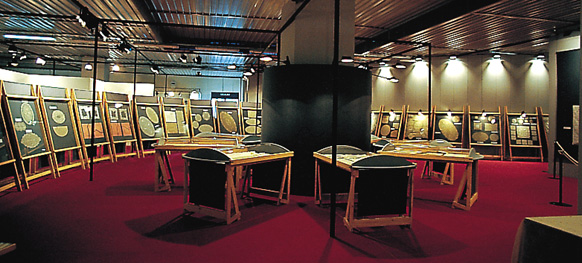6ª Biennial 2003

This success, as far as the number of visitors is concerned, is a confirmation for the Biennial formula, which has been seen to be the only event in the Cantù area which is able to involve institutions, operators, artists, schools, townspeople and volunteers who love this art.
LACE AND CLOTHING
The precious art of lace, over the centuries, has found an important application in clothing and traditions of use. Refined, elegant, sumptuous veils and an infinite range of bonnets, necklines, cravats, all with meticulous attention to detail have given rise to artefacts which are true gems in thread, light webs, a play of flowers and sprays, chiaroscuro all skilfully created by the lacemakers’ expert hands, not only in Cantù.
The objective of the Sixth Biennial is to highlight their work, rediscovering those treasures which are jealously guarded and hidden away, as well as showing new works produced in the present, evidence that is part of our culture, works which contribute to making Cantù world-famous.
THEME
The historical section will deal with a fundamental theme of the history of lace, its use in female and male clothing.
Since the introduction of lace, in the mid-fifteenth century, it has been used as a precious decoration: linen lace edged male and female linen, at the neck and cuffs of shirts while lace with gold or silver metallic thread was applied on the fabric of clothes to form decorative elements in bands.
Its presence increased between the sixteenth and seventeenth centuries as one of the main symbols of luxury in European fashion, and dominated also in the eighteenth century, when the light and highly expensive linen lace decorated female bonnets and necklines and male cravats. After the pause of the French Revolution when the great transformation in fashion decreed their temporary disappearance, lace had already returned by the early decades of the nineteenth century, reduced however to female fashion only, where it continued to be a sought after accessory.
From 1870 onwards, in particular, bobbin and needle lace became widespread in the underlinen of elegant women, as a hidden sign of wealth, and in the same period the mechanical production of lace proposed linen or silk lace at prices which were lower than that of the handmade variety, opening up new market sectors.
The aim of the exhibition is to illustrate this historical development, drawing on private and public collections from the Cantù area and proposing valuable examples from various European manufacturing centres from the sixteenth to the twentieth century. Particular attention will be paid to the nineteenth and twentieth centuries in order to investigate how the manufacture of lace in Cantù was able to respond to the dictates of fashion.
Various artefacts will be exhibited which show well the wide range of application of bobbin lace “above and below” on female clothing, such as bonnets, shawls, underlinen, shirts and handkerchiefs, but also in children’s clothing such as baptismal gowns.
Alongside the original examples the historical context will be enriched by a significant choice of reproductions of paintings, carpets and so on, which will give a public a kind of “virtual gallery” of the fortunes of lace in fashion.
The catalogue was edited by Lace historians Marialuisa Rizzini and Thessy Schonholzer
THE INTERNATIONAL COMPETITION
To coincide with the International Lace Biennial, in the exhibition space at the Permanent Furniture Exhibition, the 5th Edition of the International Competition for Bobbin Lace Design will take place. This initiative was strongly desired by the Lace Promotion Committee to give a new drive and impulse to the creative and design phase of lace, and to its transfer to paper, important moments in the creation of lace.
The competition is open to individuals, groups, Italian or foreign, who desire to create innovative proposals, to consolidate or find new formulas, or new professional and market environments which could enable Cantù lace to maintain unaltered the fame which it enjoys.
The competition involves two categories: innovation and tradition, precisely because a future without solid roots cannot exist.


